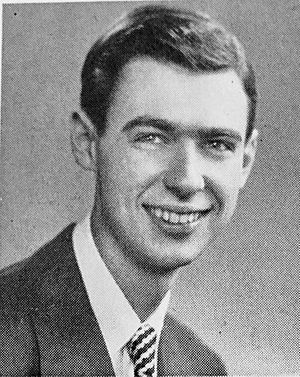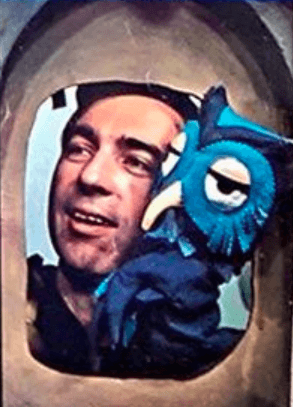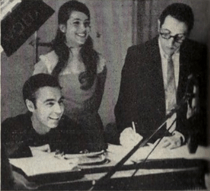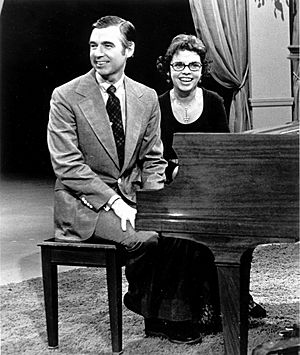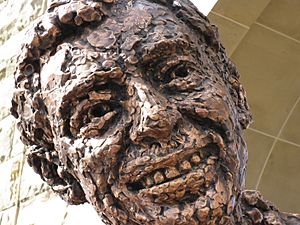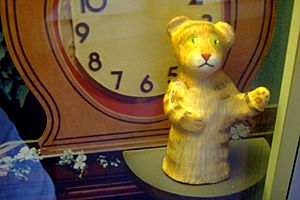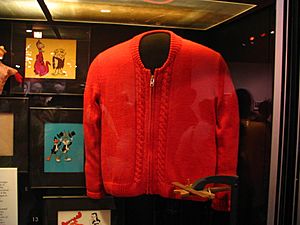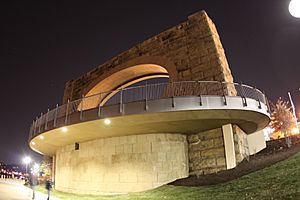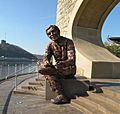Fred Rogers facts for kids
Quick facts for kids
Fred Rogers
|
|
|---|---|
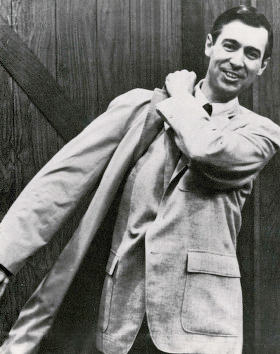
Rogers on the set of Mister Rogers' Neighborhood in the late 1960s
|
|
| Born |
Fred McFeely Rogers
March 20, 1928 |
| Died | February 27, 2003 (aged 74) Pittsburgh, Pennsylvania, U.S.
|
| Other names | Mister Rogers |
| Alma mater | Dartmouth College (attended) Rollins College (BA, 1951) Pittsburgh Theological Seminary (MDiv) |
| Occupation | Children's television presenter, actor, puppeteer, singer, composer, television producer, author, educator, Presbyterian minister |
| Years active | 1922–2003 |
| Spouse(s) |
Joanne Byrd
(m. 1952) |
| Children | 2 |
| Signature | |
Fred McFeely Rogers (March 20, 1928 – February 27, 2003) was an American television star, musician, and writer. He was also a puppeteer and a Presbyterian minister. He is best known as the creator, host, and main writer of the children's TV show Mister Rogers' Neighborhood. This show ran from 1968 until he retired in 2001.
Fred Rogers was not happy with the TV shows children were watching. He started writing and performing his own shows for kids in Pittsburgh. In 1968, his new show began to be shown across the country. For 30 years, Rogers became a beloved TV figure for children's entertainment and learning.
Rogers helped many public causes. He spoke in court to support people recording TV shows at home for later viewing. He also spoke to the U.S. Senate to ask for government money for children's television.
He retired from Mister Rogers' Neighborhood in 2001. In 2002, he was diagnosed with stomach cancer. He passed away a few months later in February 2003.
Fred Rogers received many honors. These included the Presidential Medal of Freedom from President George W. Bush. He also won a Peabody Award and was put into the Television Hall of Fame. One of his famous sweaters is now a "Treasure of American History" at the Smithsonian Institution.
Contents
Fred Rogers' Early Life
Fred Rogers was born in Latrobe, Pennsylvania. His parents were James Rogers and Nancy McFeely. His father was a businessman. His mother came from a wealthy family and volunteered at a hospital. Fred's grandfather, Fred McFeely, was the head of a large brick business. Fred grew up in a big brick house in Latrobe.
He had an adopted sister named Elaine. Fred spent a lot of time with his grandfather McFeely, who loved music. Fred started playing the piano at age five and sang with his mother.
When he was young, Fred was shy and overweight. He often studied at home because of his asthma. It was hard for him to make friends. He was sometimes bullied for his weight and called "Fat Freddy."
During high school in Latrobe, Fred became more confident. He was president of the student council. He was also a member of the National Honor Society and edited the yearbook. He finished high school in 1946. He then studied at Dartmouth College and later at Rollins College. He earned a degree in music in 1951.
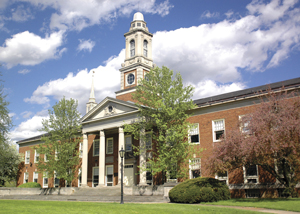
At Rollins College, Fred met Sara Joanne Byrd. They got married on June 9, 1952. They had two sons, James (born 1959) and John (born 1961).
Rogers later went to Pittsburgh Theological Seminary. He became a minister of the United Presbyterian Church in 1963. He returned to Pittsburgh in the 1960s.
Fred Rogers' Television Career
Starting in Television
Fred Rogers wanted to work in television after college. He said he went into TV because he didn't like what he saw. He wanted to use TV to help and teach children. In 1951, he got a job at NBC in New York City. He worked as an assistant producer and a floor director for music shows. He also worked on a children's show.
Rogers left NBC because he disagreed with how they used children in advertisements. In 1954, he started working as a puppeteer on a local children's show. This show was called The Children's Corner at WQED, a public TV station in Pittsburgh. The show won an award and was shown across the country.
While working, Rogers also studied theology. He was told to keep making children's TV after he became a minister. He also worked with the University of Pittsburgh on child development.
In 1963, the Canadian Broadcasting Corporation (CBC) hired Rogers. He created a 15-minute children's show called Misterogers. Rogers moved to Toronto and the show ran for three years. In 1966, Rogers moved back to the United States. He brought his show ideas to WQED in Pittsburgh.
Mister Rogers' Neighborhood
Mister Rogers' Neighborhood started in 1968. It had 895 episodes. It was shown on National Educational Television, which later became PBS. The last new episodes were filmed in 2000 and aired in 2001. By 1985, many people in the U.S. watched the show.
Each show began with Rogers coming home. He would sing his theme song, "Won't You Be My Neighbor?". Then he would change into sneakers and a zippered cardigan sweater. His mother knitted all his sweaters. On the show, Rogers would go on trips, teach new things, and show short movies. Every episode included a visit to the "Neighborhood of Make-Believe". This place had a trolley, a castle, and characters like King Friday XIII.
Rogers always fed his aquarium fish during the show. He would tell viewers he was doing this because a young blind girl wrote to him. She wanted to know each time he fed them. The show ended with Rogers singing "It's Such a Good Feeling."
Rogers believed in being himself on camera. He said kids can tell when someone is not being real. Rogers wrote almost all the music for the show. He wanted to teach children to love themselves and others. He also talked about common childhood fears with comforting songs. He once visited a children's hospital to show kids it was not a scary place.
Rogers discussed important social issues on his show. These included the assassination of Robert F. Kennedy, racism, and divorce. In one famous episode, Rogers shared a foot bath with Officer Clemmons (François Clemmons). Officer Clemmons was African-American. This scene sent a message of inclusion when racial segregation was common in the U.S.
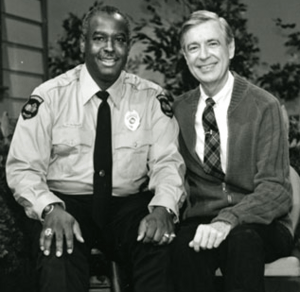
Rogers also featured children with disabilities on his show. In 1981, he met Jeff Erlanger, a boy who used an electric wheelchair. Jeff showed how his wheelchair worked. He and Rogers sang a song together. Jeff had been a fan of the show, and his parents wrote to Rogers asking if they could meet.
Rogers ended each program by telling his viewers:
-
-
"You've made this day a special day, by just your being you. There's no person in the whole world like you; and I like you just the way you are."
-
Rogers never talked about his religious beliefs on the show. He did not want any viewer to feel left out. During the Gulf War, he comforted his audience. He told them that all children would be cared for. He asked parents to promise to take care of their children.
After the September 11 terrorist attacks, Rogers made public service announcements. He helped parents talk to their children about tragic news. He told viewers to "look for the helpers." This quote is still used today after sad events. Rogers said:
-
-
"When I was a boy and I would see scary things in the news, my mother would say to me, 'Look for the helpers. You will always find people who are helping.' To this day, especially in times of "disaster," I remember my mother's words and I am always comforted by realizing that there are still so many helpers – so many caring people in this world."
-
Supporting Public Television
In 1969, Rogers spoke to a U.S. Senate committee. He asked them to support funding for PBS and the Corporation for Public Broadcasting. There were plans to cut their budgets. In about six minutes, Rogers spoke about the importance of social and emotional learning. He said public television, like his show, helped children become happy citizens.
The chairman, John O. Pastore, did not know Rogers or his work well. But after Rogers spoke, Pastore said he had "goosebumps." He told Rogers, "I think it's wonderful. Looks like you just earned the $20 million." The Senate soon increased PBS funding from $9 million to $22 million.
Supporting Home Recording
When people started recording TV shows at home with VCRs, Rogers supported it. In 1979, he spoke in a court case called Sony Corp. of America v. Universal City Studios, Inc.. Rogers said he was not against people recording his shows at home. He thought it was good because families could watch them together later.
When the case went to the Supreme Court in 1983, the judges thought about Rogers' words. The court decided that the Betamax video recorder did not break copyright laws. The court said Rogers' views showed that many TV producers were okay with people recording shows for later viewing.
In 1978, Rogers hosted a show for adults on PBS called Old Friends...New Friends. He interviewed actors, sports stars, and politicians. The show lasted for 20 episodes. In 1988, he appeared on a Soviet children's TV show. He brought his puppet Daniel Striped Tiger with him.
Rogers only played a different character once. In 1996, he played a preacher on an episode of Dr. Quinn, Medicine Woman. He also voiced himself on an episode of the PBS Kids series Arthur.
Fred Rogers' Personal Life
Fred Rogers met Sara Joanne Byrd while at Rollins College. They were married from 1952 until his death in 2003. They had two sons, James and John. Joanne was a talented pianist. She passed away in 2021 at age 92.
Rogers had an apartment in New York City and a summer home on Nantucket Island in Massachusetts. Rogers was red–green color blind. He lived a healthy life. He swam every morning and did not smoke or drink. He was a vegetarian. He said, "I don't want to eat anything that has a mother." Despite rumors, he was never a Navy SEAL and never had tattoos.
In 1991, the Pittsburgh Penguins hockey team named Rogers their celebrity captain. This was part of a celebration for the National Hockey League's 75th anniversary. A special trading card was made for the event.
Every morning, Rogers would answer all his fan mail. He would send them back to the people who wrote to him.
He won the Peabody Award in 1992. He was added to the Television Hall of Fame in 1999.
Fred Rogers' Death
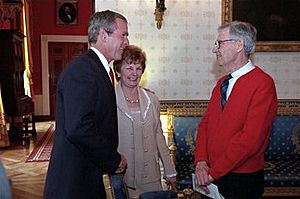
After retiring in 2001, Rogers stayed busy. He studied religion, made public appearances, and traveled. He also worked on a children's media center named after him.
By summer 2002, he had constant stomach pain. In October 2002, he was diagnosed with stomach cancer. He had surgery in January 2003, but it was not successful. A week before, he was a grand marshal in the Tournament of Roses Parade.
Fred Rogers passed away on February 27, 2003. He died less than a month before his 75th birthday.
More than 2,700 people attended his memorial service. Many famous people were there, including TV hosts and authors. Speakers remembered Rogers for his love of children, his faith, his music, and his humor. Rogers is buried at Unity Cemetery in Latrobe.
Fred Rogers' Legacy and Impact
President George W. Bush gave Rogers the Presidential Medal of Freedom in 2002. This was for his work in children's education. President Bush said that Fred Rogers showed how television can help children's spirits and teach young minds.
In 2003, the United States Senate and the U.S. House of Representatives passed resolutions. They honored Rogers for his service to children. They praised his kindness and compassion.
On New Year's Day 2004, Michael Keaton hosted a PBS TV special. It was called Fred Rogers: America's Favorite Neighbor. Keaton had worked on Mister Rogers' Neighborhood before becoming an actor. Rogers' hometown of Latrobe and Pittsburgh celebrate "Won't You Wear a Sweater Day" every year on his birthday, March 20. In 2003, an asteroid was named 26858 Misterrogers after him.
One of Rogers' famous sweaters is now at the Smithsonian Institution. It is part of their "Treasure of American History" exhibit. The Fred Rogers Memorial Statue in Pittsburgh was put up in 2009.
In June 2016, a historical marker for Fred Rogers was placed near Latrobe, Pennsylvania.
In June 2018, a documentary about Rogers' life was released. It was called Won't You Be My Neighbor? It received great reviews and became a very successful documentary. Tom Hanks played Rogers in a movie about his later life. This movie, A Beautiful Day in the Neighborhood (2019), earned Hanks an Academy Award for Best Supporting Actor nomination.
Rogers was honored on a special United States postage stamp in March 2018. On September 21, 2018, Google Doodle honored him with a stop-motion video. In October 2018, Rogers' voice and images were used in a commercial for the first time. He sang "Did You Know" for Google's Pixel 3 smartphone.
In December 2019, it was announced that a statue of Rogers would be placed in Nantucket Park in Nantucket, Massachusetts.
At the 2020 Academy Awards, Janelle Monáe sang Rogers' "It's a Beautiful Day in This Neighborhood." She wore a red cardigan sweater. When Renée Zellweger won her Academy Award for Best Actress, she listed Rogers as one of the heroes people should look for.
Fred Rogers' TV Shows
| Year | Title |
|---|---|
| 1954–1961 | The Children's Corner |
| 1963–1966 | Misterogers |
| 1964–1967 | Butternut Square |
| 1968–2001 | Mister Rogers' Neighborhood |
| 1977–1982 | Christmastime with Mister Rogers |
| 1978–1981 | Old Friends... New Friends |
| 1981 | Sesame Street |
| 1988 | Good Night, Little Ones! |
| 1991 | Where in the World Is Carmen Sandiego? |
| 1994 | Fred Rogers' Heroes |
| 1996 | Dr. Quinn, Medicine Woman |
| 1997 | Arthur |
| 1998 | Wheel of Fortune |
| 2003 | 114th Annual Tournament of Roses Parade |
Fred Rogers' Children's Books
- Our Small World (with Josie Carey, illustrated by Norb Nathanson), 1954
- The Elves, the Shoemaker, & the Shoemaker's Wife (illustrated by Richard Hefter), 1973
- The Matter of the Mittens, 1973
- Speedy Delivery (illustrated by Richard Hefter), 1973
- Henrietta Meets Someone New (illustrated by Jason Art Studios), 1974
- Mister Rogers Talks About, 1974
- Time to Be Friends, 1974
- Everyone is Special (illustrated by Jason Art Studios), 1975
- Tell Me, Mister Rogers, 1975
- The Costume Party (illustrated by Jason Art Studios), 1976
- Planet Purple (illustrated by Dennis Hockerman), 1986
- If We Were All the Same (illustrated by Pat Sustendal), 1987
- A Trolley Visit to Make-Believe (illustrated by Pat Sustendal), 1987
- Wishes Don't Make Things Come True (illustrated Pat Sustendal), 1987
- No One Can Ever Take Your Place (illustrated by Pat Sustendal), 1988
- When Monsters Seem Real (illustrated by Pat Sustendal), 1988
- You Can Never Go Down the Drain (illustrated by Pat Sustendal), 1988
- The Giving Box (illustrated by Jennifer Herbert), 2000
- Good Weather or Not (with Hedda Bluestone Sharapan, illustrated by James Mellet), 2005
- Josephine the Short Neck-Giraffe, 2006
- A Beautiful Day in the Neighborhood: The Poetry of Mister Rogers Neighborhood (illustrated by Luke Flowers), 2009
Images for kids
-
Rogers and François Clemmons having a foot bath in 1969, breaking a well-known color barrier.
-
Memorial statue in Pittsburgh, Pennsylvania, created by Robert Berks; opened to the public on November 5, 2009
-
Rogers being presented the Presidential Medal of Freedom by President George W. Bush in the East Room of the White House on July 9, 2002
See also
 In Spanish: Fred Rogers para niños
In Spanish: Fred Rogers para niños


